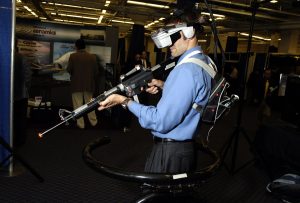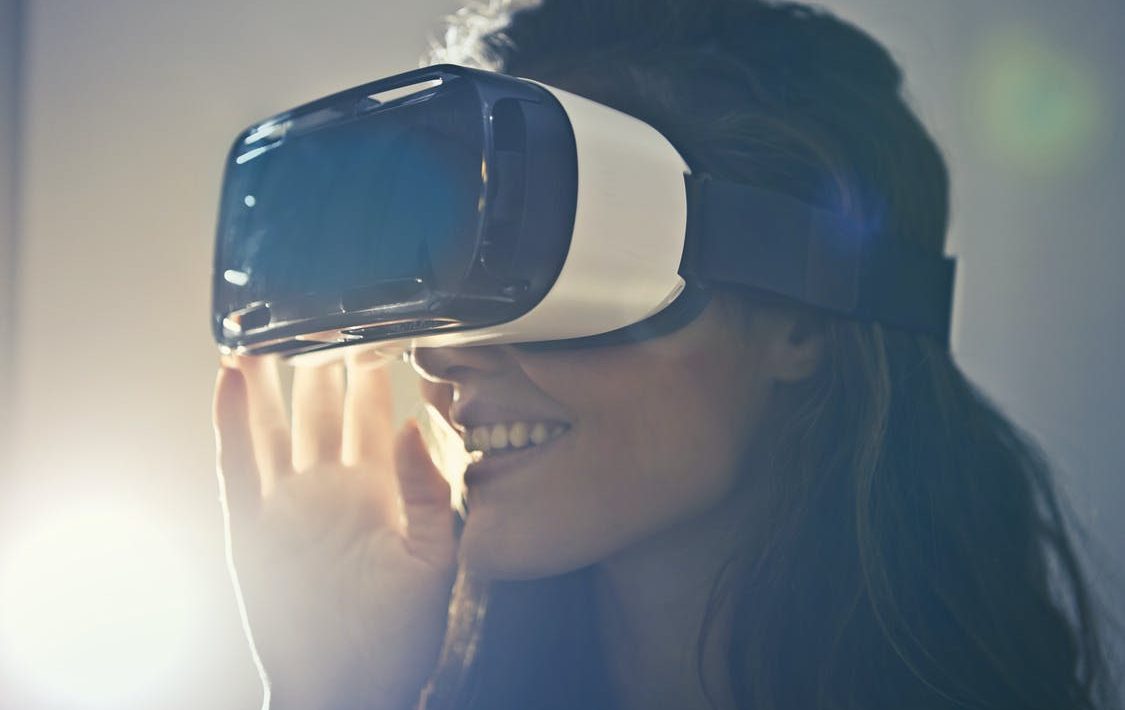Virtual Reality is a technological innovation that transfers you to a different place without changing your geographical location! Let’s take an example of a fantastic Canaletto painting. As you see the art, it takes you to Italy’s sounds and sights like how it was 250 years back. So, that is a proper form of virtual reality technology. Similarly, when you are listening to some good classical or instrumental music, and you feel it with your eyes closed, many pictures may come in front of your eyes. Now, that is also one of the virtual reality examples – an experience that does not exist in the real world. Also, when you get lost while watching a movie or reading a book and imagining the fictional characters in real life, it is an example of VR.
While all the above examples are similar to the concept of Virtual Reality, there is still a line of difference. For a better understanding of the idea, you must go through the whole article. However, to introduce the long story in short, we can define VR as an interactive, believable world of 3D. When you explore this world, you feel everything is real, and you are present there, both physically and mentally.
Table of Contents
Primary aspects of virtual reality technology
The below points will allow you to understand the concept of VR differently and more excitingly.
Believable
The virtual world must make you feel like you are a real part of it. On the other hand, you have to keep believing the same for a continuous experience. If the balance between the two things is disturbed, there will be no illusion of what we refer to as virtual Reality.
Interactive
The world of VR needs to move along wherever you go because you are a part of it. For example, when you are watching a 3D video, you may feel underwater or walking on the moon. However, there is no interaction with anyone in the virtual world.
Digitized
Why are computers important in the creation of VR? It is because nothing other than powerful computers with proper 3D graphics can do the work. Only such machines are accurate enough to create what you call an interactive and believable alternate world. Moreover, it will have to be such that you feel a part of it, and the surroundings, in turn, seem to move with you.
Explorable
There must be proper details, and VR should be broad enough for you to explore it properly. However, irrespective of how realistic painting is, it will only highlight a single scene and only one perspective. For example, if you are reading a book that has a complicated and vast story. However, you get to explore everything only in a linear way, which is, of course, the author’s perspective.

Immersive
Virtual Reality must be equally interactive and believable so that it is capable of engaging both your mind and body. For example, paintings done by war artists show pictures of conflicts. However, it is impossible for you to feel any sound, sight, smell, contact, or taste of a battle. On the other hand, imagine you are playing an online game where you are operating a flight simulator.
You will be wholly lost in a very interactive and realistic for several hours. Still, you will not quite get the feel of operating a real simulator. In the latter case, when VR technology comes in action, you feel like you are sitting in a cockpit’s hydraulically functioning setup. Plus, the forces while the machine tilts and tips feel very real, and it is almost like flying an actual plane.
As you read the above aspects, you may already start getting and understanding that there is a difference between the ordinary 3D effects and virtual reality. Moreover, virtual reality meaning is quite different from AR or Augmented Reality, for example, 3D. In VR, the effect happens gradually, and you will start immersing yourself in a virtual world, that seems believable. In this case, the interaction occurs in two ways. It means that how you respond to the virtual surroundings, they return to you as well. Besides, everything you hear and see in VR alters to adjust to a newer perspective just when you turn back.
Types of virtual reality
VR or Virtual Reality is often misused in the form of a typical marketing buzzword. Several brands use the term to promote 3D movies, video games, or TV programs. Unfortunately, none of them are proper examples or fall under the category of VR. The primary reason for the same is that none of the movies, games, or shows make you partially or entirely immersed in an unreal world. However, there are some computer simulations or interactive games that can justify virtual reality meaning. In this context, you will get a better understanding of the justification if you explore VR variations.
Fully immersive
The essential requirement for the ultimate VR experience is a list of a few things. They are-
- A detailed and plausible world for you to explore
- At least one good computer simulation or model should be capable enough to sense the functioning and adjust the scenes accordingly. So, what happens is that everything happens in real-time. It means that all you hear or see will move along with you, just like it happens in real life.
- Most importantly, you will need good quality hardware and connect it to your computer. Only then can you fully immerse yourself in the world of VR as you move around. For example, you will need an HMD or Head Mounted Display with stereo sound and double screens. Moreover, you will have to put on sensory gloves. If you are looking for an alternative idea, in this case, you can go for surround- sound loudspeakers. As a result, you can move from one part of a room to another, and the images around you also move. The same sounds and images get projected from outside.

Non-immersive
In case you are using an advanced technology flight simulator on your PC, it has chances of justifying the term non-immersive VR. It is especially the case when there is a considerably full screen, surround sound feature, and you are using proper headphones. Plus, it becomes more realistic if there are a few other control options, including a joystick. The fact is that every person has a different requirement. So, you may not want to immerse yourself fully in an alternative world. For example, as an architect, you may create a 3D model of a building as a part of a presentation. Further, you present it to your clients and call it an example of VR. While the model is highly effective for the project purpose, it does not gradually immerse the clients in an alternative world. So, that is an example of non-immersive VR.
Let’s take another example of non-immersive VR. Suppose, a digital archeologist creates a fantastic 3D reconstruction of some long-lost settlement. Now, the archeologist doesn’t need to want to take you back to the 10th or 12th century. Neither will he try to incorporate any kind of smell, taste, or sound of the prehistoric times. However, you still get a rich experience from the reconstruction compared to ordinary pastel drawings or say animation movies.
Collaborative
Have you heard of VR games such as Minecraft and Second Life? Do you feel that they are proper examples to justify VR? These games, on the one hand, do tick off a few boxes, but surely, they do not cover it all. It means that these are believable, digital creations, interactive, and explorable. However, they are incapable of immersing you in an alternative world partially or entirely.
Out of all that analyzation, one unique aspect of these compared to other examples of cutting-edge VR is the kind of collaboration it has to offer. It means that when you are playing games involving VR technology, they give you an option to share your experience with other people. Moreover, the same happens on a real-time basis most of the time. According to experts, experience-sharing and collaboration will be two of the essential VR features in the future world.
Web-based
The VR concept was like the fastest-growing, as well as the hottest technology by the end of the 1980s and in the first part of the 1990s. However, the rapid increase in popularity of the WWW or the World Wide Web almost killed the enthusiasm of understanding VR. Although experts and scientists were continually trying to find our ways of creating virtual worlds on the Web, people were not interested in the same. The scientists were utilizing technology that was similar to HTML. It was called VRML (Virtual Reality Markup Language). However, people in the world were engrossing themselves in understanding the Web.
The main reason for doing so is that the Web offered people innovative ways to access the real world’s realities. For example, there were new ways of sharing thoughts, experiences, and ideas with people through social media platforms. Moreover, publishing information and shopping were some of the other skills that started attracting more people towards the Web. As we see that social media platforms, such as Facebook, are taking considerable interest in advanced technology, the future is becoming a little predictable. According to computer scientists, the upcoming world of VR will be both collaborative as well as web-based.
Augmented Reality
Presently, tablets and smartphones have put powers of first supercomputers directly in our pockets and hands. Suppose you are on a world tour, and you visit a historical attraction. It can be anything like a fascinating heritage site, a buzzing foreign city, or a pyramid. In this case, you will not want anything related to VR.
Instead, what will make you happier is an enhanced way of experiencing the real beauty right in front of you. Now, that is what gives rise to the concept of AR or Augmented Reality. For example, when you visit the site, just take out your smartphone, and point it towards the pyramid. What happens is all information about the place pops up on the screen of your smartphone. Well, that is Augmented Reality for you.
In AR, the goal is to connect real-world experiences to the alternate world of information. The combination can be created using the functions on the Web. You must understand that none of these words are of VR. However, exploring both the world of AR and that of Reality simultaneously does justify the concept of VR in quite a few ways.
For example, how is it possible that a smartphone automatically gives you information about a particular place? How come the scenes on your phone screen keep changing as you move from one part of the city to another? In technology, these questions are very similar to those that VR system developers have to decode. So, now you know that there are strong similarities between the concepts of VR and AR. Moreover, both work hand-in-hand in a lot of scenarios.

Equipment and applications of VR
Here is a list of equipment that is required to understand the essential output and input VR devices.
- HMDs or Head-Mounted Displays
- Immersive rooms
- Data gloves
- Wands
Now, let us go through the major fields in which a person can apply concepts of Virtual Reality.
- Education
- Scientific Visualization
- Medicine
- Industrial architecture and design
- Entertainment and games
Final thoughts
Several pros and cons come along when you are trying to understand the concept of VR. However, it is of utmost importance that you keep in mind the importance of VR in the present and future world of technology. The upcoming developments and innovations will require this technology at every step. So, knowing the basics of VR can take you a long way in this journey.











